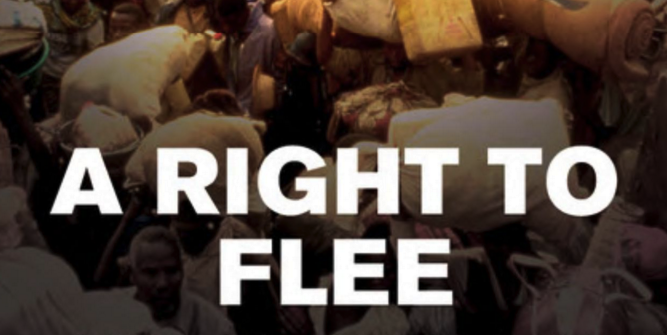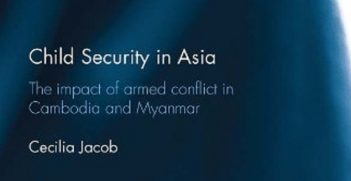A Right to Flee

A Right to Flee by Phil Orchard is a scholarly, well-researched, historically detailed and carefully analytic book. Through a lens crafted from the disciplines of political science and history, the author explores the evolution of refugee protection structures and norms over several centuries. He puts forward a framework to explain significant changes over more recent times in the parameters for refugee protection, the responsibilities at issue and the governing legal norms. The framework is used as a methodology to clarify and explain continuity and change in states’ refugee policies over time.
An analysis that locates refugee protection squarely in the intersection where national interests, collective interests and norms come together is sound. Orchard’s main thesis is simple enough, despite the sometimes quite technical language. At its centre are legal and normative protection “regimes” which at any one time will frame and even determine how states will respond to refugees seeking their protection, and major crises that periodically and effectively up-end them. The crisis events variously render the prevailing state refugee policies unsustainable without alteration or replacement, and progressively lead to regime change.
More specifically, Orchard reasons that refugee protection has proceeded over a considerable period within an evolving regime of rights, responsibilities and norms that, in addition to changing incrementally, periodically undergo major shifts that substantively alter the overall refugee protection architecture. It is argued that such shifts have historically been caused by events of crisis proportions, marked by significant alteration in the number of refugees and/or the composition of the outflow. These crises have served to delegitimise the existing protection regime of the time, causing states to lose confidence in it and provoking an active search for more effective alternatives. This in turn has opened up possibilities for “norm entrepreneurs”, notably the UNHCR, to develop and promote new normative understandings. These often, but not always, help to shape alternatives in more positive terms. As these consolidate locally, nationally and even internationally, a new regime settles in, until the next major crisis emerges to throw up its inadequacies.
The author posits the emergence of four main successive regimes over the last two centuries: the laissez-faire regime, the inter-war refugee regime, the post-war regime and the non-entry regime of today.
The historical analysis of how this change might be explained in the case of significant policy shifts over time is a highly useful piece of research. The book is at its best in its review of historical social, legal and political developments that together crafted the UNHCR of today and its primary legal tool: the 1951 Refugee Convention. There is a lot of useful historical material, inter alia drawn from careful reading of original source material including UN debates and the travaux preparatoire of the Convention. These bring out the divisions among states as to how tightly the organisation should be tied into the Secretariat, its longevity, the width of its mandate, how it should be funded and whether or not its remit should include assistance as well as legal protection. Interestingly these dilemmas continue, albeit in a very changed operational context, making this early historical revisiting a valuable resource when it comes to assessing the challenges for the organisation today.
There are, however, important modern contextual issues which would have given greater weight and nuance to the conclusions of the book had they been more thoroughly analysed. The overall approach of the book is predominantly developed world-centric. An important omission is any seriously detailed look at the significant contribution to normative change that has come out of Africa and Latin America, and the crisis events there driving this.
Then there is the fact that, crises aside, there are other drivers of change to which the book does not really do justice. Orchard acknowledges in chapter two that “crisis events are [not] the only way that change occurs. In fact norm entrepreneurs can play a further important role by modifying state practices incrementally, such that a crisis is diverted or delayed.” Experience certainly supports this observation. In this connection, Orchard could have paid greater attention to significant developments, not crises as such, which have been making important incremental contributions to normative change. Here one could, for example, mention efforts to develop a Common European Asylum System. So too developments within the UN system, pursuant to its Transitional Agenda for change, might have been given some attention.
In the context of the book’s core analysis of norm entrepreneurs and the role of the UNHCR, UN transformation is a qualitative change process. This particularly pertains to how the UNHCR is able to play its central protection role and who might also be considered relevant norm entrepreneurs.
Such additional analysis would have given the book greater nuance in responding to its final question: “Whither the International Refugee Regime?” This is a hugely important current issue. Arguably, the world is going through precisely one of these seismic events, which is likely to be the precursor for important regime change of the sort at the centre of Orchard’s analysis. He suggests in his conclusion that “the non-entrée regime is at a turning point”. This is very likely true.
It would be interesting indeed at this point to apply the analytic framework developed by Orchard to a predictive end, using his model to assess whether the current situation might well prove to be a crisis of such proportions that it will now drive a new regime change, bringing burden sharing to the fore and giving tangible meaning to the norm of international solidarity for refugee protection.
The topic of prevailing refugee norms needs to be further developed by focusing on responsibility sharing, and international solidarity and burden.
Phil Orchard, A Right to Flee, (Cambridge: Cambridge University Press, 2014)
Reviewed by Erika Feller FAIIA, who is the former UNHCR Assistant High Commissioner for Protection. She is currently a Vice-Chancellor’s Fellow at the University of Melbourne. This article is published under a Creative Commons Licence. It may be republished with permission.





